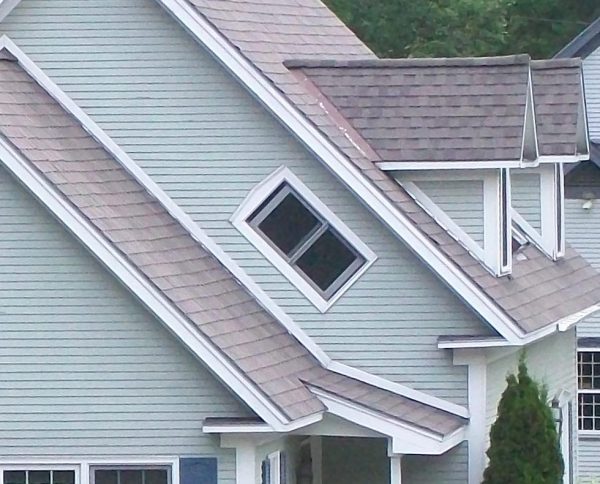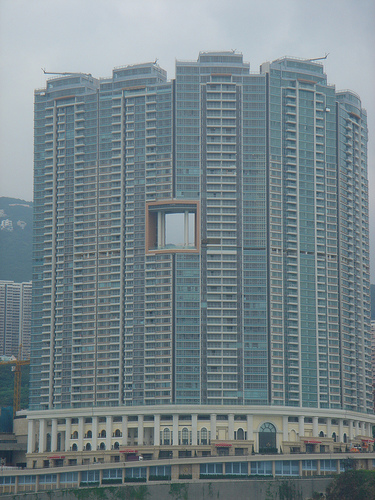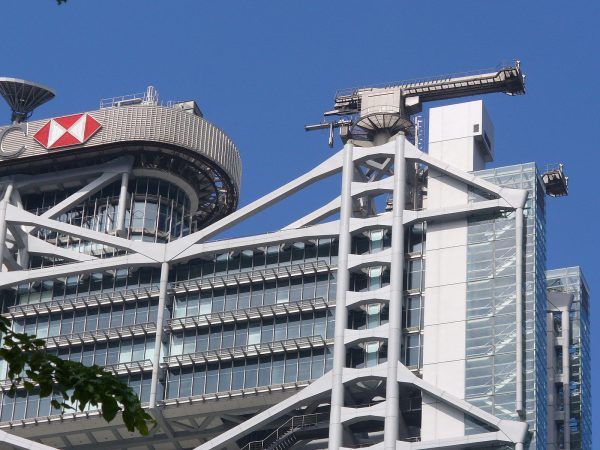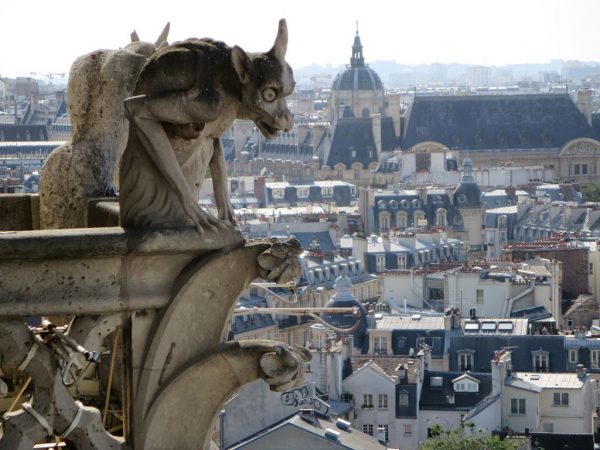Haunted Vernacular by Kurt Kohlstedt
There’s a subset of culturally specific designs that are associated with less, well, worldly concerns, like warding off ghosts, appeasing spirits or otherwise dealing with figures of myths and legends. Take, for instance, the “witch window,” which is a type of fenestration mostly found in the Northeastern United States. “Witch windows” are basically conventional vertical windows, just tilted at an angle. And so their sides end up aligning with sloped roofs rather than straight walls or floors. As the story goes, witches can’t fly through the tilted frames, hence the name “witch windows.” Some other theories say that these openings are also sometimes called “coffin windows” which suggests that they were made to let caskets pass in and out of upper stories.

In the American South, you can find blue paint on the ceilings of outdoor porches, sometimes referred to as “haint paint.” This is said (by some) to ward off ghosts or spirits. The idea is that the spirits will confuse the blue for water, which they are reluctant to cross. Or they might think it’s the sky, so they’ll go up toward it instead of swooping inside. Another possible explanation for the blue paint is that it’s just a holdover from Victorian traditions of using more natural colors on homes—in this case, tied to the local availability of crushed indigo in the South. Another is that the practice originally had to do with keeping away insects, either because they confused the paint for the sky, or because blue paints used to be made with lye, which is caustic.

In Thailand and other Southeast Asian countries, there are actually purpose-built structures called “spirit houses.” Instead of trying to keep spirits out of normal homes, this approach actually provides alternatives, inviting spirits to stay in custom-built alternative dwellings. And in Hong Kong, you can find tall buildings with huge gaps in the middle that basically look like someone punched a hole in the side of a skyscraper. The theory is that these gaps enable dragons to fly unhindered back and forth between the mountains and the water.

In the 1980s, the Bank of China Tower by the world-famous I.M. Pei got a lot of grief for ignoring feng shui. Meanwhile, in that same decade, when Foster & Partners was designing the HSBC bank building nearby, they took the advice of feng shui experts. In the end, they wound up adding some maintenance cranes mounted on top of the latter structure. These are actually functional things, but they look a lot like cannons that are pointed at the I.M. Pei building. Symbolically, these are meant to deflect the other building’s negative energies.
Some forms of superstitious vernacular architecture are much smaller in scope, like the tradition of “topping out” that originated in Scandinavia. Historically, the idea was that putting a tree or wreath on top of a new house or other kinds of buildings would appease tree spirits — so it was a kind of “thank you” to the forest for providing the wood used to make architecture.
There’s a constant back and forth between function and folklore, and at some point, it can be hard to separate the two. Gargoyles have supernatural associations, but they’re also part of very pragmatic drainage systems.
Welcome mats, too, are useful for wiping off dirty boots, but the idea of having wards or welcomes at thresholds goes back thousands of years. So it can be a real challenge in some cases to tell what came first, the practical or spiritual reasoning behind a given design strategy.




Comments (20)
Share
The hsbc hq in HK was designed and constructed (1983) before the Bank of China building was constructed in 1985. It’s true that Foster and Partners consulted fung shui experts, but that was a matter of course because they were constructing in HK and it was going to be an important landmark.
To clarify: the construction of the two buildings actually overlapped (one was completed in late 1985, the other started earlier that year). That said, it is true that the HSBC building was started before the Bank of China building, though the cranes mentioned were added to the HSBC indeed were (as far as I can tell from my research) designed to address the poor feng shui of the BoC building – I am not sure if they were added later or during the overlapping construction period. Source: https://archive.nytimes.com/www.nytimes.com/fodors/top/features/travel/destinations/asia/china/hongkong/fdrs_feat_74_10.html?n=Top%25252 -= Kurt
I love this show. I love this episode, I appreciate all of you that work on it: Please don’t use the word spirit animal if you are not a member of an indigenous community. If you are I’m sorry for butting in but heads up.
This is the same thing I came over here to comment on. Great show, lovely intent. However, it’s about time we abolished “spirit animal” from the general lexicon. There are other options for inferring the same intended meaning without intruding on or mocking marginalized people.
There is no mocking or intruding context here.
I believe the television program mentioned in the Raccoon story was a 2012 episode of the PBS program, Nature, called “Raccoon Nation.” It’s online at: https://www.pbs.org/wnet/nature/raccoon-nation-introduction/7518/
It mentions the problems Japanese temples have had with Raccoons along with lots of other fascinating information about these amazing creatures.
at the top of beechwood canyon, below the hollywood sign, there is also a high fence with a gate. above the gate is a camera surrounded by a ring of red lights. it is terrifying. it looks straight of some orwellian police state. the gate has a proximity sensor and makes a very aggressive sounding tone (not a beep but a sustained tone) as you approach it
Hi!
Thank you for all the beautiful episodes.
Here is one more example of such architecture inspired by Rudolph Steiner and anthroposophy (even though I’m not a fan of that esotericism):
https://www.designboom.com/architecture/rudolf-steiners-goetheanum-anthroposophical-expressionist-concrete-architecture-gesamtkunstwerk-06-21-2019/
You might remember the tanooki suit from Super Mario 3 video game.
https://www.mariowiki.com/Tanooki_Suit
About the Hollywood Sign Access. I think I’m with the residents on this. At least it sounds like that while the sign is public, there isn’t (good) public infrastructure to hike to it. As part of that public going through the neighborhood isn’t treating the neighborhood nice nor does they city police/clean/maintain the neighborhood. I’d do my best to keep my property nice.
I live in Centretown and have a correction to make to the Jack Purcell story. They aren’t lamp posts at all, they’re just sculptures. After some research I found a rendering that shows the light coming through the holes that would’ve held the string, which would be post-redesign but pre-implementation. I think this was an attempt to make the ‘trees’ a little more exciting, but wasn’t feasible since they were never designed to be lights. Now we have brutalist quidditch rings and a story.
Hey I did the hike! Didn’t even know there’s instructions. I came on a bus to the eara near (not even the park, but the other side!) by and just started walking not knowing it’ll be such a winding complex walk throgh all these houses. Ended up walking about an hour on a very hot day and feeling sorry for the residents having tons of people like me come by.
Two comments about the rampaging raccoons: First, are there reasons TNR (trap, neuter & release) wouldn’t work to control the population? That would take away the Buddhists having to kill a living creature issue. Second & on a happier note: did you notice that the theme song for “Araiguma Rascal” is the first tune in the classic arcade game Frogger? :D
I live in Boston and use mass transit to get everywhere. I don’t even own an automobile. I used Apple Maps and typed in The Hollywood Sign for directions using transit. Amtrak to San Bernardino, Metrolink SB line to Union Station, then choice of AV Line or Red Line to two different bus lines that get you within 25-35 minute walk to the sign. The walk is likely through the neighborhood mentioned in the story. I used to date a woman from LA and would go out ther for Christmas. The first time I was told the only way to get to the family house in an east of LA suburb near Corona was by airport limo/van. Very expensive and took forever. After that I figured out a way to get within a 20 minute drive of the house using bus and Metrolink. Easy!
I find the story about raccoon particularly fascinating. The effect of animated series “Rascal Raccoon” on the population surge of Alien Raccoon has apparently been acknowledged in a study:
https://www.researchgate.net/publication/228486361_Present_status_of_invasive_alien_raccoon_and_its_impact_in_Japan
Also somewhat related to the topic:
https://journals.plos.org/plosone/article?id=10.1371/journal.pone.0106565
I love your show, keep up the great work!
Just listening to the witch window story and you solved the blue paint in chefchawan Morocco. Our guide did say the paint was a mosquito repellent:)
The most obvious superstitious influence on architecture that I see is the omission of the 13th floor. My ER doesn’t have a room 13.
So interestingly in the United States the European Starling and the House Sparrow are exotic invasives because of a persons love of literature namely Shakespeare.
Pikachu is based of the Northern pika (Ochotona hyperborea) though I kinda think it looks more like the American pika (Ochotona prince’s)
Thanks for the mini-stories, I love them (and you guys)! The raccoon story reminded me of another one by Radiolab (Stranger in Paradise), about how raccoons came to Guadeloupe.
Also when I was a kid in Hawaii in the 60s, there was a popular song about raccoons. This cartoon is how I remember it – https://www.youtube.com/watch?v=FeMaFJsvm9w. I did a little searching and discovered this song is about the native Japanese raccoon dog, not the interloper – Shojoji no tanuki bayashi (Raccoon Dogs Dancing at Shojoji Temple.
I had Mickey Mouse Club LP album from the 1950s, when I was a kid, with a Japanese song and an English verse translation. I thought of digging it out to record that to share with you, but I found a close version online:
https://www.youtube.com/watch?v=QxDVcI4HHRk
The English verse on the album I have is
Sho, sho, sho jo ji; Sho jo ji is a raccoon
He is always hungry, so he sings of koi koi koi
We used to sing along, as closely as we could hear it. My sister sang it for a Japanese friend at college, and he said we had most of it right.
According to the intro on the 45 in the video, the song went with a kids’ circle dance.
So there was already some interest in raccoons, among Japanese children, in or before the mid-1950s.